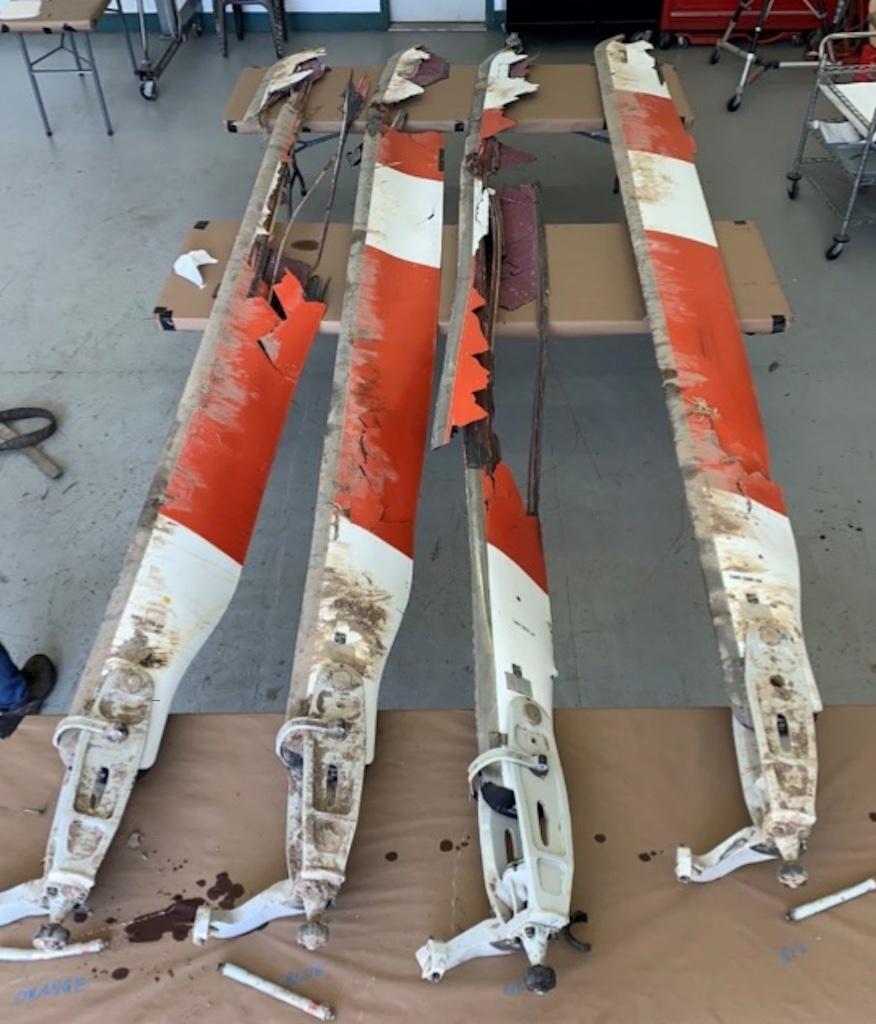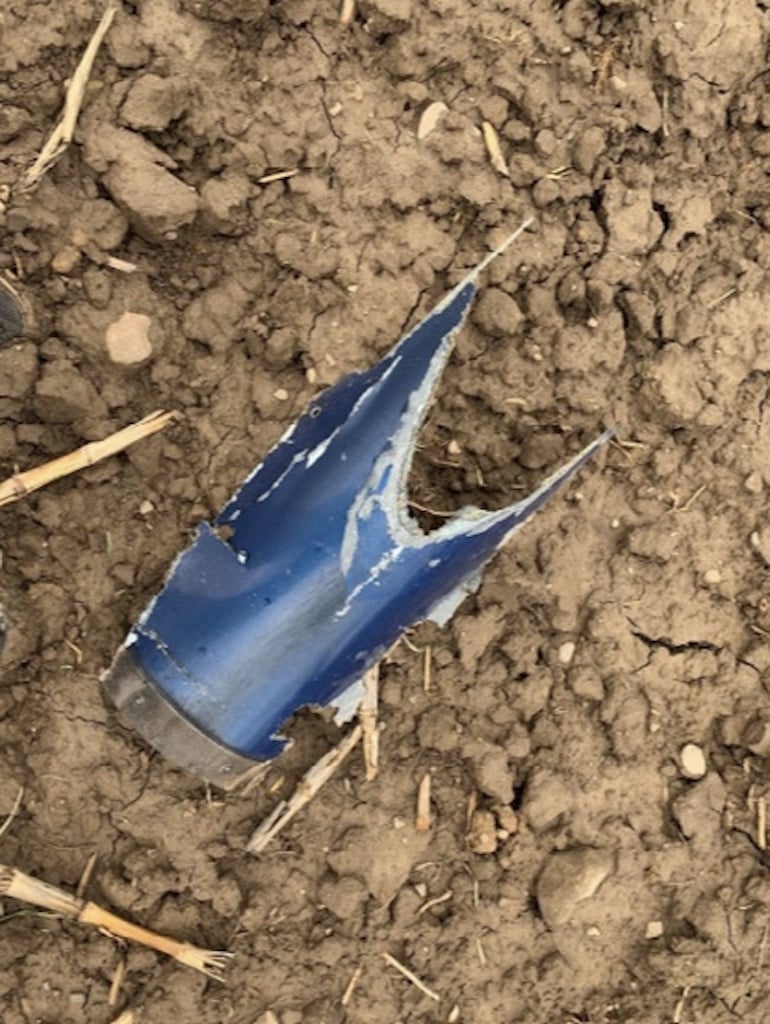
Examination of the Bell 429’s main rotor blades revealed impact marks.
Flight training should not result in unrecoverable flight conditions or catastrophic structural failures, yet two recently released National Transportation Safety Board (NTSB) accident reports have eerily similar circumstances.

Both accidents involved a helicopter’s main rotor cutting off the tail boom, resulting in an uncontrolled plummet to the ground, killing the flight instructors and pilot-trainees. Both were instructional flights which involved training for recovery from vortex ring state (VRS).
The first example involved a flight instructor from the manufacturer assigned to conduct multiple training flights of an operator’s pilots in a Bell Textron Canada 429 on April 26, 2022, near Elba, New York. The first operator pilot-trainee who received training from the instructor noted that their second entry into the VRS recovery maneuver developed a very high descent rate.
The pilot-trainee, waiting for further guidance from the instructor, stated that he did not know why they were going so deep into VRS. The instructor was just sitting still with his hands on his lap. The pilot-trainee felt uncomfortable with the excessive descent rate and commenced a recovery rather than waiting for further guidance from the instructor pilot. The remainder of that first training flight was uneventful.
The second training flight of the day was the accident flight. The pilot-trainee held an ATP pilot certificate, CFI-helicopter and CFI-instrument helicopter ratings, and had accumulated 6,030 flight hours of total flight time with 580 flight hours in the make and model.
The electronic data recorder revealed that the helicopter entered into the VRS envelope with a vertical descent rate between -800 fpm to -1,300 fpm. Shortly thereafter, multiple abrupt control inputs were recorded. This started with a forward cyclic input followed by a nearly full-aft cyclic input within 1 sec., as well as a concurrent full-down collective input with increasing left pedal input. It is likely that these abrupt control inputs resulted in the main rotor blades contacting the tail boom, causing an in-flight breakup of the helicopter and subsequent violent impact with the ground, leading to fatal injuries for both occupants.
Further Analysis of Control Inputs

The NTSB tried to understand the reasons why the pilot(s) might have applied the abrupt control inputs, but that could not be determined at the conclusion of the investigation. The control inputs did not conform with either of the two methods used to recover from a VRS.
This is perplexing because both the pilot-trainee and the manufacturer’s flight instructor held CFI-Helicopter ratings, and thus would have been required to show proficiency in demonstrating a VRS entry and recovery to a student during the practical exam.
Furthermore, since the maneuvers were deliberately performed, the pilot-trainee had sufficient time to set up the maneuver, anticipate the reactions of the helicopter and know precisely ahead of time the control inputs to make, as opposed to a sudden or unexpected event that can cause a negative effect on a pilot’s performance.
According to the FAA’s Helicopter Instructor’s Handbook (FAA-H-8083-4), the traditional recovery from VRS is accomplished by lowering the nose to increase airspeed, and/or partially lowering collective to exit the vortex. This moves a helicopter out of its downwash and into translational lift. When the aircraft is clear of the disturbed air, the pilot should confirm a forward speed indication and initiate a climb to regain the lost altitude.
The Vuichard recovery technique requires increasing the collective to a climb power setting and applying left pedal to maintain heading while simultaneously applying right cyclic to 20 deg. angle of bank, then back to wings level to generate a lateral movement. As soon as the advancing rotor blade reaches the upward flow of the vortex, the recovery is complete.
Second Similar Accident
A similar accident occurred on March 25, 2022, near Rowlett, Texas, during flight instruction in a Robinson R44 of a pilot-trainee who had a commercial single-engine land pilot certificate and was training to add a helicopter rating. The lesson syllabus included emergency procedures to include VRS recognition and recovery.
This was the second training flight of the day for both the flight instructor and the pilot receiving instruction. The instructor was qualified to teach in the Robinson R22 and R44 helicopters and had completed the Robinson Helicopter Pilot Safety Training course on May 5, 2021.
The R44 was not equipped with the equivalent of a flight data recorder, thus accident investigators relied on flight track data, video and a witness statement. During the last minute of ADS-B data the helicopter was flying at about 1,975 ft. MSL and 7 kt. ground speed.
A witness observed the helicopter appearing to hover in one place, then move about 100 ft. and hover in place again. This motion was repeated a second time. The witness then observed something separate from the helicopter, which appeared to fall backward. The aircraft continued a downward uncontrolled descent and nose-dived into the ground. Both the instructor and the pilot receiving training died in the impact.
A 4-ft. section of the tail boom, with the tail rotor assembly still attached, impacted the top of a commercial building about 300 ft. from the main wreckage.
Examination of the main rotor blades revealed contact marks that were consistent with impact marks on the separated section of the tail boom. The teeter stops were severely damaged. The main rotor drive shaft displayed scuff marks where the teeter stops were damaged. This signature is consistent with extreme teetering of the main rotor.
Without a flight data recorder, it is not possible to determine the exact maneuver or the control inputs made at the time of the tail boom separation. The NTSB said it is possible that the flight instructor was demonstrating, or the pilot receiving instruction was performing, a VRS entry and recovery at the time of the tail separation. The main rotor’s contact with the tail boom is consistent with improper flight control inputs or low rotor RPM.
NTSB accident reports and recommendations of manufacturers and regulators contain insights that should be considered in flight training of VRS recovery of helicopters, as well as other abnormal and emergency conditions.
The NTSB noted the likelihood that the flight instructor in the Bell 429 accident described earlier did not provide adequate information to the pilot-trainee on how he would receive training for VRS, to include how they would identify, enter and exit VRS.
Additionally, the investigation of the Bell 429 accident determined that the rapid cyclic input would not have allowed sufficient time for the airframe attitude to adjust to the main rotor inputs from the cyclic because of the rapid aft cyclic movement.
Airbus Helicopters has performed tests to gather data for a more complete understanding of the aerodynamic loads on the helicopter. Airbus Helicopters does not consider VRS as a normal part of the flight domain of any rotorcraft. Dynamic loads on some components of the rotor system increase significantly in full VRS and are not completely taken into account in the components’ service life. Airbus Safety Information Notice No. 3463-S explicitly recommends against placing the helicopter in fully developed VRS.
In January 2024, Robinson Helicopter Co. amended its flight manual to reflect this same limitation on VRS training. It reads in part: “Do not allow the condition to develop beyond the initial indications and avoid large control inputs. Recovery should be initiated at the first sign.”
The two accidents discussed in this article also highlight a continuing issue for helicopter flight training. Emergency and abnormal procedures (EAP) training is risky, time consuming and expensive when done in an actual rotorcraft. In some emergencies it is necessary for the pilot to make an immediate and accurate control input to counter the abrupt undesirable motion of the rotorcraft.
How do we adequately prepare pilots for critical maneuvers and emergency procedures in all phases of flight and in less-than-ideal conditions without causing so many accidents?
Importance Of Simulators
The European Union Aviation Safety Agency (EASA) leaflet “Training and Testing of Emergency and Abnormal Procedures” acknowledges that a number of helicopter accidents happen during the training or checking of EAP in which the instructor allowed the student to put the aircraft into a position where they were not able to recover it safely.
EASA’s Rotorcraft Safety Roadmap recommends, whenever possible, to train and check EAP in a flight simulator training device (FSTD). This would be particularly important for maneuvers with razor-thin margins such as VRS, tail rotor malfunctions or autorotations.
Unfortunately, the reality in the industry is that suitable flight-training devices are not always available. This means that a considerable amount of EAP is still conducted in an actual helicopter.
These two fatal accidents unfortunately remind us that unrecoverable consequences can quickly occur if the pilot’s inputs are incorrect, insufficient, excessive or poorly timed. There are flight conditions in which the primal control inputs must be exactly correct for that specific make/model of aircraft, as the consequences of less-than-correct control inputs will further aggravate the loss of control.
The correct control inputs must be made immediately, or else the condition of the aircraft will exceed the limits for recovery and potentially cause a catastrophic structural failure.






Comments